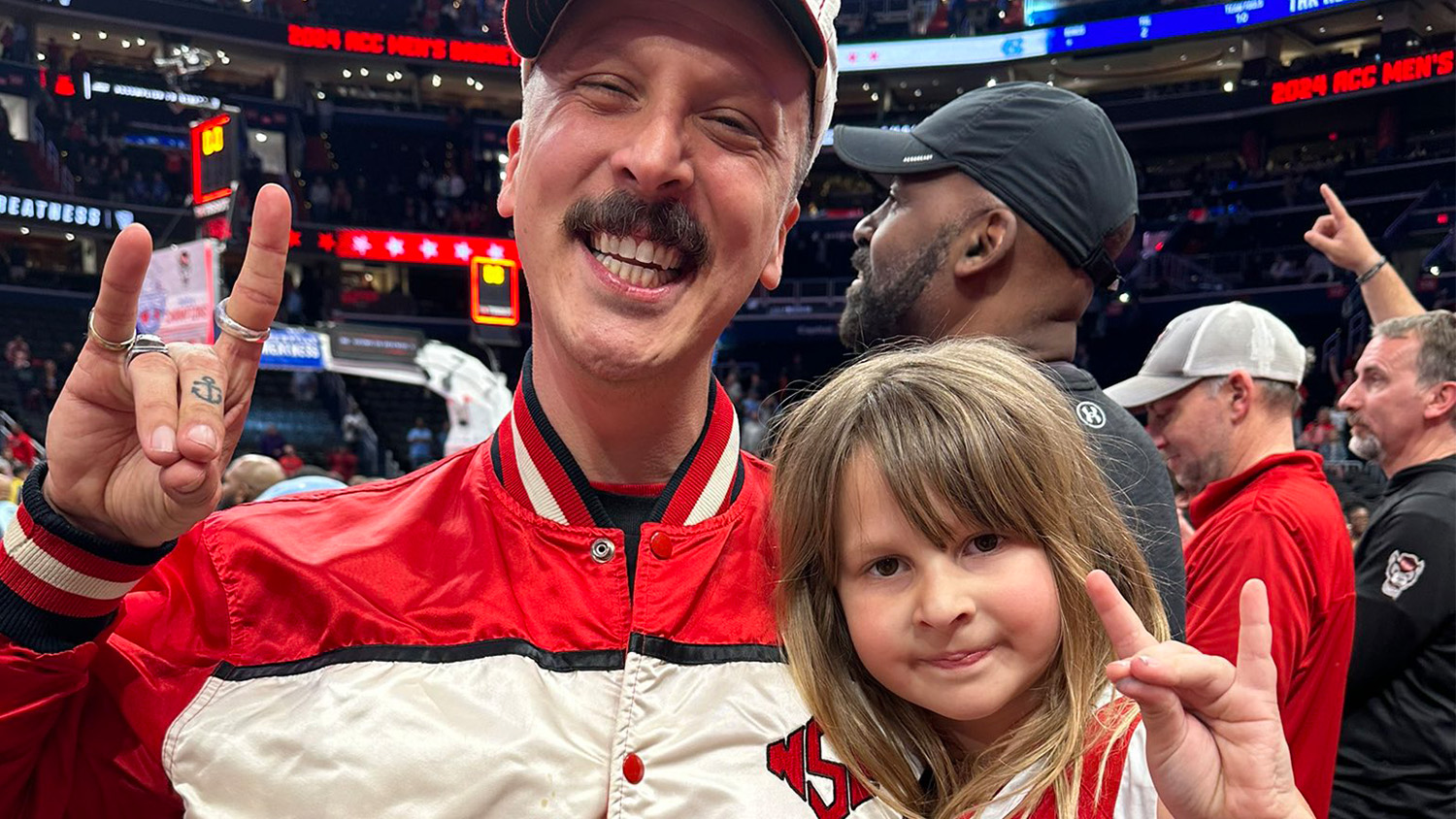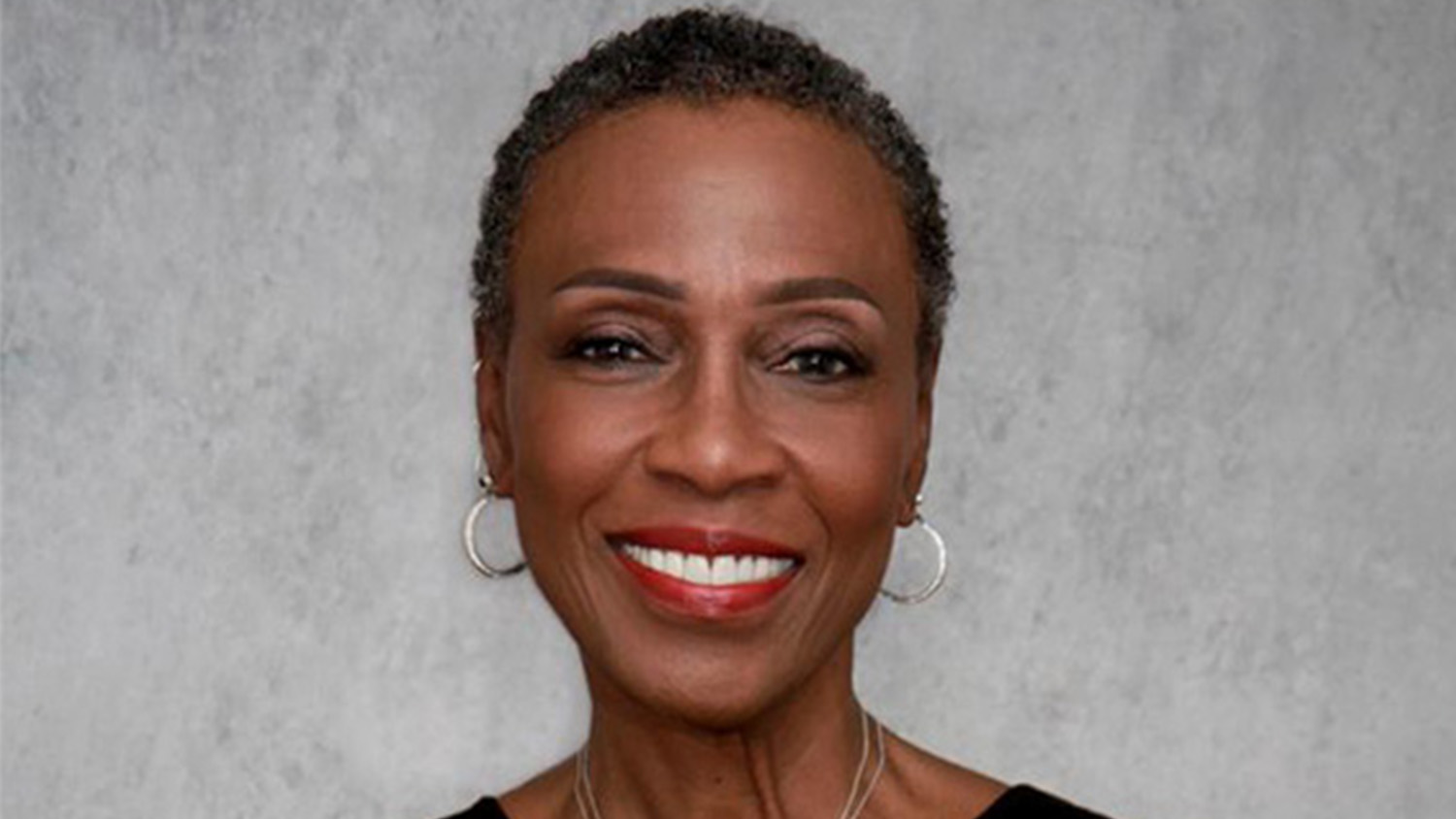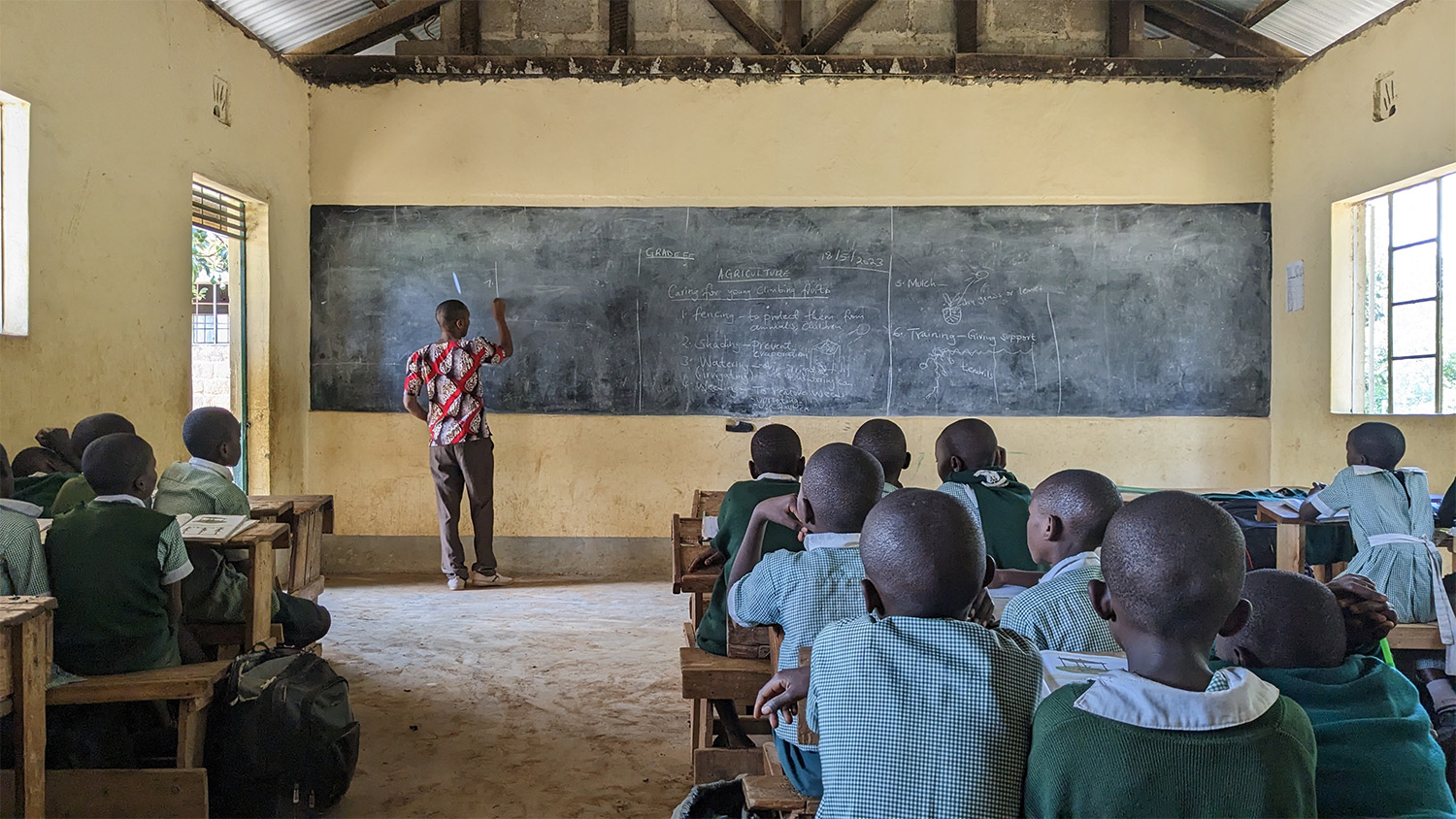Plowing a New Future
NC State is looking to data, drones and other forms of technology to reshape agriculture so that farmers can continue to feed the world.
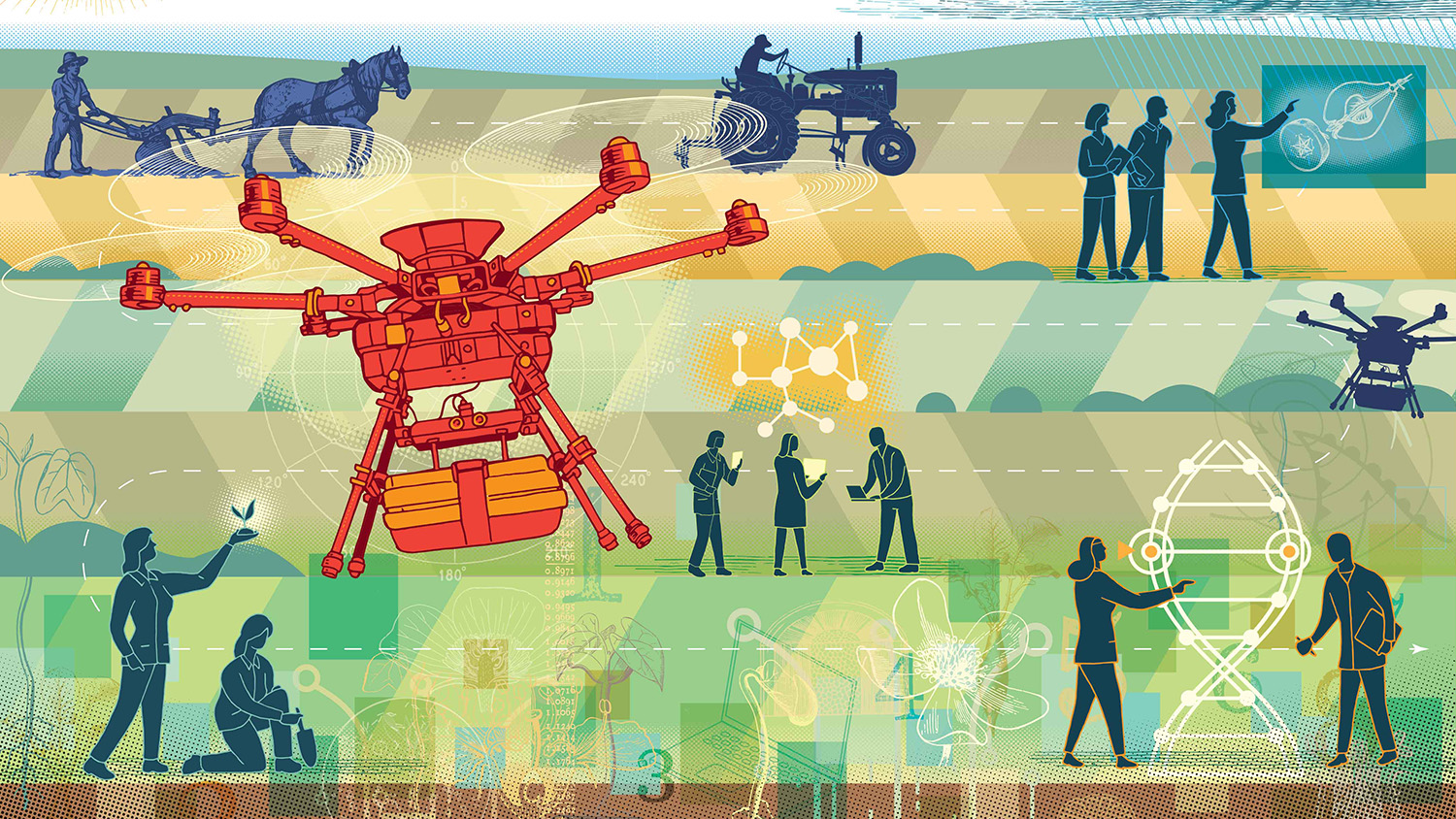
It’s been roughly 80 years since tractors started to replace horses — not to mention the occasional mule — as the source of power for farmers plowing their fields. And for generations of farmers, that clunky piece of machinery was about as high-tech as things got for the planting and harvesting of their crops.
Recent years have seen technology start to creep into agriculture, with some farmers relying on drones to survey their fields or allowing GPS to steer a driverless tractor. But in an age when technology seems to be overtaking everything at a head-spinning pace, agriculture has largely stuck to its roots.
That’s about to change, primarily because farmers must become more efficient and sustainable in order to feed a growing planet while farm acreage is dwindling, extreme weather is increasing and the cost of everything from fertilizer to labor is on the rise. And NC State is helping to lead the charge, one that will utilize everything from artificial intelligence to robotics to fundamentally change how our food is grown, fertilized and harvested.
“There are going to be many, many more mouths to feed in the future,” says N.C. Agriculture Commissioner Steve Troxler ’74, who has childhood memories of steering a mule as it pulled a plow through the soil on his granddaddy’s farm in western North Carolina.
“We know that our natural resources are shrinking as the result of development and other things. We see massive increases in the cost for things like fertilizer and pesticides. The only way we get there is through research and technology.”
NC State is transforming its agricultural research efforts, bringing together teams of professors from different disciplines to tackle questions ranging from how to make fertilizer less expensive and more effective to how cover crops such as clover and rye can reduce runoff from storms. The university is figuring out new ways to use drones, sensors and robots to give farmers a clearer picture of what’s happening with their crops. And it’s using artificial intelligence to speed up the development of new breeds of crops and take some of the guesswork out of farming.
The effort falls under the umbrella of what is known as the Plant Sciences Initiative (PSI). At its center sits a new building on Centennial Campus that is unlike any ever built at NC State, one designed to bring disparate groups from across campus and elsewhere together for brainstorming, research and collaboration. With cutting-edge greenhouses perched on top of the building and open, reconfigurable lab spaces inside, the building is a brick-and-steel symbol of NC State’s ambition.
That ambition is to make NC State a world leader in a quest to revolutionize agriculture. “Trying to be the best plant science center globally is obviously a really big ambition,” says Adrian Percy, who left a career in the private sector to come to NC State last year as the first executive director of the Plant Sciences Initiative. “But it will have a meaningful impact in North Carolina and beyond the borders of our state.”
Trying to be the best plant science center globally is obviously a really big ambition, but it will have a meaningful impact in North Carolina and beyond the borders of our state.
–Adrian Percy, executive director, Plant Sciences Initiative
Or as Chris Reberg-Horton, a professor of cropping systems at NC State, argues: “We’re on the verge of the biggest technological revolution in agriculture that we’ve had in decades. I tell my students all the time, in 10 years you’re not going to recognize what’s going on on a farm.”
Cow College 2.0
Leading the effort is the university’s College of Agriculture and Life Sciences (CALS). Historically, the college has been a traditional program, running breeding programs for a wide range of crops grown in North Carolina and using a network of Extension agents to keep farmers in the loop on the latest research by soil and crop scientists at the university. Much of that work speaks to NC State’s mission as a land-grant university to serve the state, but it has also led to periodic barbs from rival schools describing NC State as a “cow college.”
When he became the dean of CALS nearly 10 years ago, Richard Linton had a view of what the future could hold for farming — and for the work of agricultural researchers and breeders at NC State. (Linton left the university in February to become the president of Kansas State University.) “North Carolina was ready for something big in the agriculture and food system space,” he says.
Steve Lommel, associate dean for research at CALS, says the college was well-positioned to take a significant leap forward. With agri-tech companies like Bayer CropScience, BASF, Monsanto and Syngenta, the Research Triangle Park had become what Lommel calls “the galactic center of corporate plant science research.”
NC State’s College of Engineering offered the tantalizing prospect of pairing agriculture faculty with engineers and computer scientists who could bring new ideas to the challenges facing farmers. And then there are the university’s connections to farmers and their commodity groups throughout the state.
“Shame on us if we can’t leverage what we are doing in this state,” Lommel says. “Get somebody together with an engineer, a mathematician, a big data scientist, a physicist, an economist, and really go after these problems in an interdisciplinary way.”
Linton decided that an innovative new building — the first for CALS in many years — could serve as the intellectual hub for this effort, where engineers and crop scientists, data scientists and farm groups, corporate researchers and soil specialists could come together to share ideas, collaborate on research and have access to the best technology available. He worked with Troxler, corporate partners and commodity groups dedicated to promoting and supporting different crops to raise money — from private sources and a statewide bond issue — to make the building a reality.
“We can be the best in the world in plant sciences,” Linton says, using a term that encompasses the scientific research of roughly 400 million species of plants that have a huge impact on life on this planet. “That was our aspiration from day one. No one has what we have.”
A World to Feed
Dan Ward ’86 is a seventh-generation farmer, growing corn, peanuts and soybeans on about 2,000 acres in Bladen County in southeastern North Carolina. When he studied agricultural engineering at NC State, he went home to Clarkton on weekends to help his dad with the farm. “I never went to football games until the last game of the season, when the crops were in,” he says. “I never wanted to do anything else. I love watching the crops grow, watching nature do its thing.”
Ward is 58 years old now, and he has seen the ups and downs of farming. He has also seen an increase in the use of technology on farms, and recognizes that it comes with potential gains and potential headaches. He uses GPS to map his fields so that he can take soil samples for every acre to determine how much lime and fertilizer to apply to different areas. He hires a firm to analyze the results and upload them to a computer that tells his fertilizer spreader what to do in each section of his farm.
“It’s easier in one sense, but it’s also more technical,” he says. “If things go wrong with it, I have to find a way to figure it out. I can’t wait for a John Deere man to come fix it. So we have to learn more electronics and computer science.”
Farmers will need to embrace the opportunities presented by technology, says Ashley Collins ’05, chief executive officer of N.C. Peanut Growers, even if those opportunities come with their share of difficulties. Collins says the sort of “revolutionary thinking” behind the new building and the PSI is needed, pointing out that smaller countries such as the Netherlands are excelling in agriculture because they are more open than the U.S. to technology that can improve farming. Using more greenhouses to grow vegetables, for example, has decreased their use of water and pesticides.
“We have a world to feed,” Collins says. “And that’s what it’s going to take, a technological revolution in agriculture.”


A Scientific Village
Amy Grunden and Christine Hawkes are microbial biologists at NC State, drawn to tiny organisms that can only be seen through a microscope. Their enthusiasm for their work is apparent, and it’s not hard to imagine them spending hours alone in a lab studying microscopic samples and compiling data for their latest research projects — Grunden’s on organisms known as extremophiles and Hawkes’ on fungi.
But they also recognize that there are significant advantages to having researchers from other disciplines — even if it’s only to bring a fresh set of eyes to a challenge — on their teams.
“What’s been really great is it’s not just a whole bunch of clones of me,” says Hawkes, who grew up watching nature specials on television with her grandparents.
She was in graduate school when she learned about microscopic fungi found in plant leaves and roots. “Plants are full of microbes,” Hawkes says. “You think about the microbes in your gut and what they do for your nutrition and health. But the same can be said of plants. It’s the microbes that mediate their physiology, their nutrient uptake, their ability to tolerate stress.”
She is working with microscopic fungi alongside researchers in disciplines such as computer engineering, plant pathology and forestry. They’re trying to determine if the fungi can be manipulated to help the microbes in crops deal with extreme weather such as drought and diseases that are predicted to lead to sharp declines in crop yields. “We view these fungi . . . as one tool in our arsenal,” Hawkes says.
Her team has managed to identify about 30 different species of fungi found in plant leaves that can cut the growth of damaging pathogens by more than 50 percent. But that work has all been done in petri dishes, in a lab, and must still be tested in plants. That introduces all sorts of variables, and that’s where big data enters the picture, enabling Hawkes to identify the most important genes in fungi for predicting the best outcomes in plants.
“As long as we keep finding the things we’ve been finding,” she says, “I think we’re on the right road.”
Grunden says working with faculty from other disciplines, as well as researchers at three Danish universities, increases the likelihood that research she is doing on extremophiles — organisms that live and thrive in extreme environments — leads to something that can be used to improve conditions on a farm. “I have expertise on the microbial physiology part, but I can’t necessarily model a whole system or scale the system up,” she says. “It very much takes a scientific village.”
Reberg-Horton, the cropping systems specialist who oversees research being done under the PSI to make agriculture more resilient, says it hasn’t always been easy to get other departments to work on agriculture. He recalls approaching professors in electrical engineering about working together on research projects years ago.
“It was impossible to get them excited about that,” he says. “They had big defense contracts. They did other things. And now that’s completely different. I know a ton of folks in electrical and computer engineering, and in computer science. There’s dozens of them working on agricultural problems.”
Katharina Stapelmann, an assistant professor in the Department of Nuclear Engineering, is a perfect example. She is an expert in something called technical plasma, the result of applying energy to gas so that it can be used in a myriad of ways to change materials to make them more adhesive or, say, able to absorb liquids. Staplemann is working on ways plasma can be used to improve cancer treatment and wound healing.
“Plasma is sort of everywhere, but we don’t really see it,” she says. “There’s a lot of technology that wouldn’t be available without plasma. It’s a hidden gem.”
Shortly after Stapelmann arrived at NC State from Germany in 2017, she met another new faculty member at an orientation workshop for new university employees. He mentioned that he was working on a project involving soil sensors, and she quickly realized that such sensors might help with work she was doing with plasma and nitrogen-based fertilizers. When the PSI was launched in 2017, the two professors joined forces with others to explore ways that plasma could help produce fertilizers that would reduce waste and runoff for farmers.
Stapelmann is quick to point out that it would be difficult for her to tackle such a challenge on her own.
“I don’t know anything about soil, and I don’t really know a lot about plants,” she says. “We need experts from different areas to succeed. I can come up with the greatest technology on the planet, but if the farmers think it’s useless, too expensive or too inconvenient, they’re not going to use it.”
A New Breed
While it may be years before some of the research being done under the PSI translates into tangible changes on farms, quicker results are expected in the various plant breeding programs run by CALS.
Farms in the midwestern United States are dominated by staple crops such as corn, wheat and soybeans. As a result, large international corporations control the genetics and breeding of those crops. North Carolina agriculture is much more diverse, with farmers also growing sweet potatoes, peanuts, blueberries, tomatoes, strawberries, apples and more. None of those crops are big enough to draw corporate investment, so the state’s farmers rely on breeding programs at NC State and other public universities to develop varieties that will produce high yields, be resistant to diseases and pests, and handle drought or heat. And they need to taste good.
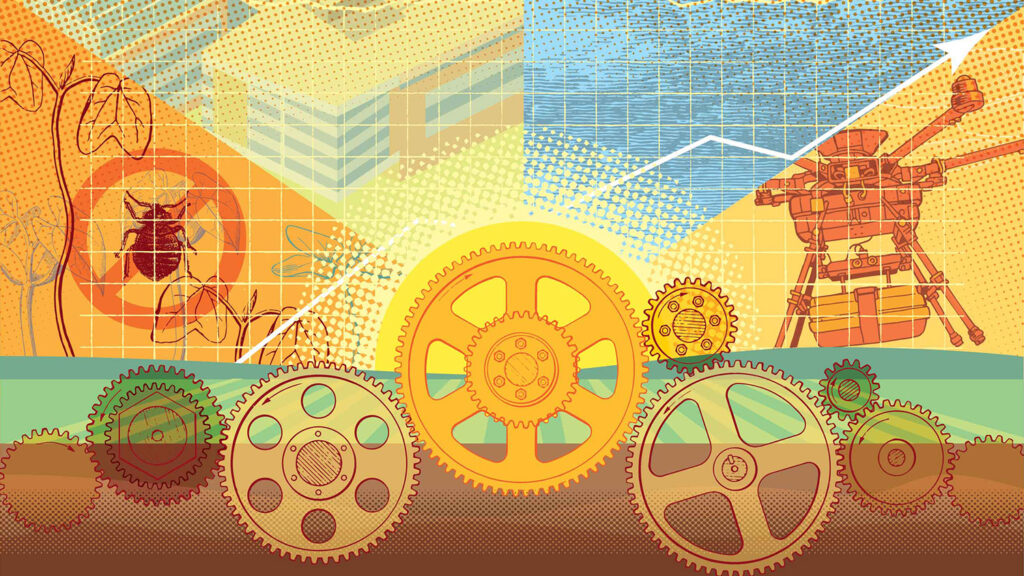
But plant breeding is a complex process, and it can take years of field trials to test hundreds, if not thousands, of different lines trying to find one that will work for farmers.
. . . I have to get more efficient and more sustainable every day.
–Dan Ward ’86, farmer, Bladen County
NC State, though, is hoping to speed up that process through the PSI — using sensors to gather data above and below the soil and then using artificial intelligence to make sense of all the data. The end result, they hope, is the development of more new breeds that meet farmers’ needs for better yields, tastier crops and fewer problems with disease and extreme weather conditions. “We’re going to increase our odds,” Lommel says, “of a higher frequency of home runs.”
Jeff Dunne ’13 MS, ’16 PHD, runs the peanut breeding program at NC State, and much of his effort is focused on developing new varieties that produce more peanuts and are resistant to a disease called early leaf spot. He uses drones to capture images of peanut plants to detect diseased leaves.
“We are being more accurate in [detecting] leaf spot than walking around a hot field, eyeballing the plants,” Dunne says. “The idea here is we can get consistent evaluations and, with those images, we can go back at any time to see if we missed something. The drone info is incredibly valuable. It gives us the tools to make better decisions.”
And with more data on how various test breeds performed in different climates and different soil, Dunne is confident he will eventually be able to develop breeds of peanuts targeted for different microclimates within a farmer’s land.
“If we’re cooking on all those cylinders, it will enable us to make the best decisions,” he says. “It will lead to better breeding lines for us and, ultimately, the best lines so our growers can benefit.”
Dan Ward, the farmer in Bladen County, would welcome that as he sees an eighth generation of his family (his daughter and son-in-law) working on the farm. “We’re never going to fool Mother Nature,” he says. “We’re still going to have to be able to know when to work the dirt and when not to work the dirt. But we’re losing farmland every day, so we’re going to have to make more crops off of less acres. I have to get more efficient and more sustainable every day.”
- Categories:
